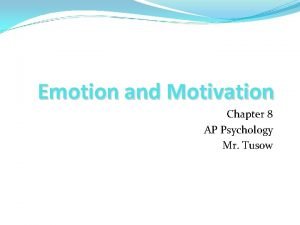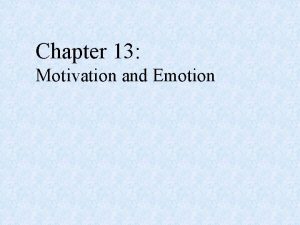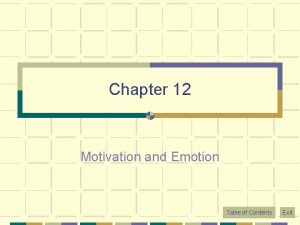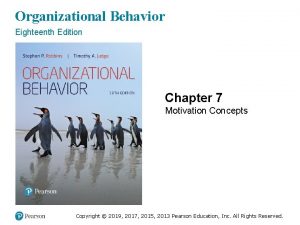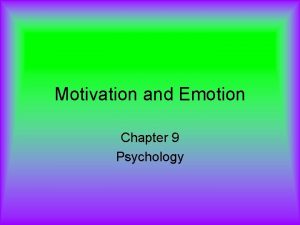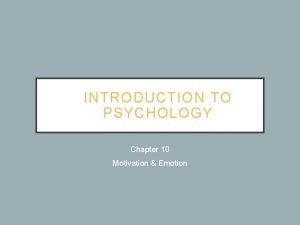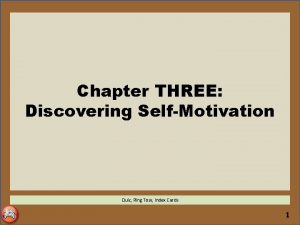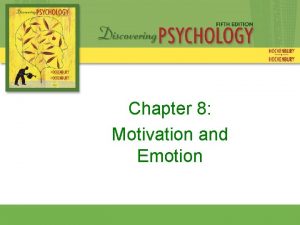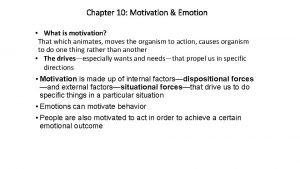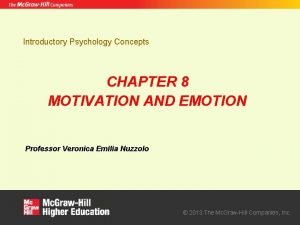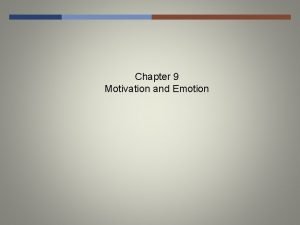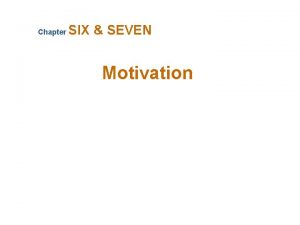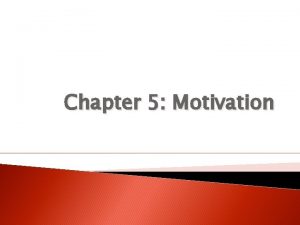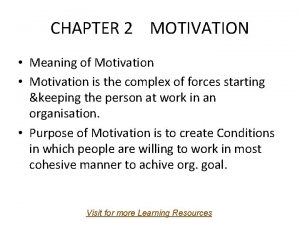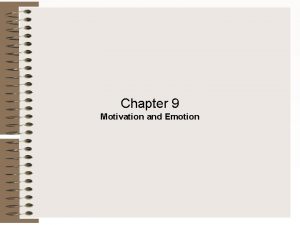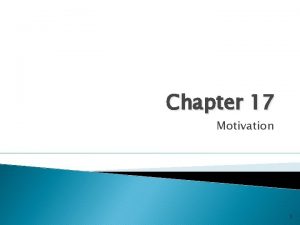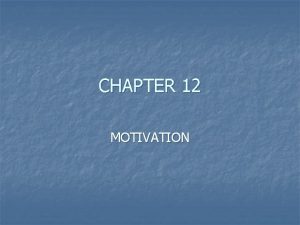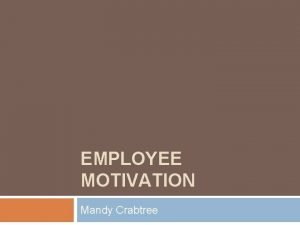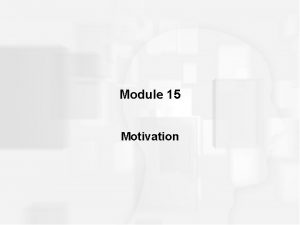Chapter 17 Motivation What Is Motivation v Motivation














- Slides: 14

Chapter 17 Motivation

What Is Motivation? v. Motivation ØIs the result of an interaction between the person and a situation; it is not a personal trait. ØIs the process by which a person’s efforts are energized, directed, and sustained towards attaining a goal. § Energy: a measure of intensity or drive. § Direction: toward organizational goals § Persistence: exerting effort to achieve goals. ØMotivation works best when individual needs are compatible with organizational goals.

Early Theories of Motivation v. Maslow’s Hierarchy of Needs v. Mc. Gregor’s Theories X and Y v. Herzberg’s Two-Factor Theory v. Mc. Clelland’s Three Needs Theory

Early Theories of Motivation v. Maslow’s Hierarchy of Needs Theory ØNeeds were categorized as five levels of lower- to higher-order needs. § Individuals must satisfy lower-order needs before they can satisfy higher order needs. § Satisfied needs will no longer motivate. § Motivating a person depends on knowing at what level that person is on the hierarchy. ØHierarchy of needs § Lower-order (external): physiological, safety § Higher-order (internal): social, esteem, selfactualization

Maslow’s Hierarchy of Needs

Early Theories of Motivation (cont’d) v. Mc. Gregor’s Theory X and Theory Y ØTheory X § Assumes that workers have little ambition, dislike work, avoid responsibility, and require close supervision. ØTheory Y § Assumes that workers can exercise self-direction, desire responsibility, and like to work. ØAssumption: § Motivation is maximized by participative decision making, interesting jobs, and good group relations.

Early Theories of Motivation (cont’d) v. Herzberg’s Motivation-Hygiene Theory ØJob satisfaction and job dissatisfaction are created by different factors. § Hygiene factors: extrinsic (environmental) factors that create job dissatisfaction. § Motivators: intrinsic (psychological) factors that create job satisfaction. ØAttempted to explain why job satisfaction does not result in increased performance. § The opposite of satisfaction is not dissatisfaction, but rather no satisfaction.

Motivation and Needs v. Three-Needs Theory (Mc. Clelland) ØThere are three major acquired needs that are major motives in work. § Need for achievement (n. Ach) The drive to excel and succeed § Need for power (n. Pow) The need to influence the behavior of others § Need of affiliation (n. Aff) The desire for interpersonal relationships

Contemporary Theories of Motivation v. Goal-Setting Theory v. Reinforcement Theory v. Designing Motivating Jobs v. Equity Theory v. Expectancy Theory

Motivation and Goals v. Goal-Setting Theory ØProposes that setting goals that are accepted, specific, and challenging yet achievable will result in higher performance than having no or easy goals. ØIs culture bound to the U. S. and Canada. v. Benefits of Participation in Goal-Setting ØIncreases the acceptance of goals. ØFosters commitment to difficult, public goals. ØProvides for self-feedback (internal locus of control) that guides behavior and motivates performance (selfefficacy).

Motivation and Behavior v. Reinforcement Theory ØAssumes that a desired behavior is a function of its consequences, is externally caused, and if reinforced, is likely to be repeated. § Positive reinforcement is preferred for its long-term effects on performance. § Ignoring undesired behavior is better than punishment which may create additional dysfunctional behaviors.

Designing Motivating Jobs v. Job Design ØThe way into which tasks can be combined to form complete jobs. ØFactors influencing job design: § Changing organizational environment/structure § The organization’s technology § Employees’ skill, abilities, and preferences ØJob enlargement § Increasing the job’s scope (number and frequency of tasks) ØJob enrichment § Increasing responsibility and autonomy (depth) in a job.

Equity Theory ØProposes that employees perceive what they get from a job situation (outcomes) in relation to what they put in (inputs) and then compare their inputsoutcomes ratio with the inputs-outcomes ratios of relevant others. § If the ratios are perceived as equal then a state of equity (fairness) exists. § If the ratios are perceived as unequal, inequity exists and the person feels under- or over-rewarded. § When inequities occur, employees will attempt to do something to rebalance the ratios (seek justice).

Expectancy Theory ØStates that an individual tends to act in a certain way based on the expectation that the act will be followed by a given outcome and on the attractiveness of that outcome to the individual. ØKey to theory is understanding and managing employee goals and the linkages among and between effort, performance and rewards. § Effort: employee abilities and training/development § Performance: valid appraisal systems § Rewards (goals): understanding employee needs
 Overjustification effect
Overjustification effect Chapter 13 motivation and emotion
Chapter 13 motivation and emotion Chapter 12 motivation and emotion
Chapter 12 motivation and emotion Chapter 7 motivation concepts
Chapter 7 motivation concepts Chapter 9 motivation and emotion quiz
Chapter 9 motivation and emotion quiz Chapter 10 motivation and emotion
Chapter 10 motivation and emotion Dapps goal
Dapps goal Chapter 8 motivation and emotion
Chapter 8 motivation and emotion Motivation chapter
Motivation chapter Chapter 10 motivation and emotion
Chapter 10 motivation and emotion Chapter 8 motivation and emotion
Chapter 8 motivation and emotion Incentive theory ap psychology
Incentive theory ap psychology Chapter 9 motivation and emotion
Chapter 9 motivation and emotion Motivation to learn an overview of contemporary theories
Motivation to learn an overview of contemporary theories Prärational
Prärational
